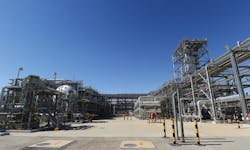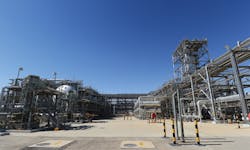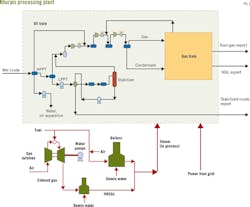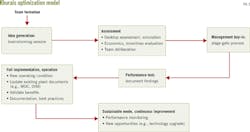Optimization yields gains for Saudi crude processing giant
Kamarul A. Amminudin
Mohammad F. Muaibed
Saudi Aramco
Dhahran
Since 2000, Saudi Aramco has implemented an energy-conservation program to enhance efficiency throughout its operations. These efforts have paid off in energy savings valued in terms of cost/boe consumed internally that could otherwise be exported for profit.
Aramco recently implemented the Accelerated Transformation Program (ATP) to further these efforts by making energy conversation a key component of the company's operational excellence efforts in the area of efficiency.
This article describes one Saudi Aramco oil processing plant that has carried out various energy-conservation and process optimization initiatives.
Processing at Khurais
Commissioned in 2009, the Khurais central processing facility (KhCPF) has the capacity to produce 1.2 million b/d of Arab Light crude, associated gas, and condensate from three major fields: Khurais, Abu Jiffan, and Mazalij. The plant also injects water to sustain reservoir pressure for these fields.
Fig. 1 shows a simplified process diagram of KhCPF. Crude oil from the fields is first processed at the gas-oil separation plant (GOSP), where stabilized crude is produced through a series of separation systems. These include the high-pressure production trap (HPPT), the low-pressure production trap (LPPT), and the stabilizer.
The stabilized crude is then sent to the terminals for export by pipeline. The gas separated from the GOSP is compressed and sent to the Khurais gas plants, where it receives dehydration, refrigeration, and stripping to meet its hydrocarbon dew-point requirement.
The gas product from the plants is piped as sour gas to another gas plant for sweetening.
Similarly, the condensate recovered as NGL from the stripper bottom is sent to another gas fractionation train.
To support these processes, Saudi Aramco has built a utility system that provides steam and other utilities. All power requirements are supplied by a contracted power company.
Assessing optimization
From KhCPF's start-up to stable operations, engineers and operation team members looked for energy conservation and yield enhancement.
Initially, they thought to "cherry pick" specific accepted best practices. Adopting and adapting these practices into an operating facility, however, is not as straight forward as it may seem.
Each processing plant is unique even if the plants share a common product. Implementation requires a thorough assessment before a practice can be adopted.
In the case of KhCPF, this process was begun by identifying some issues that hindered the plant's performance.
The team considered all aspects of implementing an optimization program-from economic incentives and operability to safety implications. In the end, their decision took into account critical trade-offs in two clusters: high efficiency with lower reliability, safety, and operability; and lower efficiency with higher reliability, safety, and operability.
After simulation and testing, results were presented and recommendations were made. For KhCPF, initiatives that demonstrated value creation were implemented as new operating conditions and, in most cases, reflected in Management of Change (MOC) documentation.
This entire process was captured as a best practice for the rest of Saudi Aramco and can be seen in summary in Fig. 2.
Process, energy optimization
Saudi Aramco adopted the energy-intensity-index (EII) metric to measure KhCPF's efficiency performance. This performance metric accounts for all energy consumed and generated to produce one unit of oil equivalent as product. The EII is monitored daily by the operating facilities, and there is a corresponding key-performance indicator for an individual facility to meet.
At KhCPF, the EII metric components offered possibilities for process and energy optimization. To achieve this, the energy component of the EII metric must be minimized through energy optimization, while the product component is maximized through process optimization.
Ultimately, the objective is to reduce EII as much as possible every year. This reduction depends on whether optimization initiatives involve operational improvement or capital cost.
Generally, operational improvement exploits "low-hanging fruit" and results in marginal improvements, and capital-cost improvements contribute to substantial energy savings through such initiatives as cogeneration projects.
In some cases, however, operational improvements-applied appropriately in the right situation-can be harnessed to great effect. Such was the case at KhCPF, as will be seen.
Understanding the interconnectivity of a plant's operations is essential to identifying any opportunities for process or energy optimization. KhCPF is made up of oil, gas, and utility operations that rely on each other to operate effectively.
For this reason, a chemical engineer should lead optimization efforts, but there should be a close working relationship between all engineers and operators. This is necessary to generate the key optimization initiatives identified as:
• Maximizing crude yield through pressure optimization at the separation traps (process optimization).
• Maximizing oil-train capacity to minimize power consumption (energy optimization).
• Maximizing heat-recovery steam generation to minimize dependence on auxiliary boilers (energy optimization).
Maximizing crude yields
The impact of pressure and temperature on the vapor-liquid equilibrium in a crude mixture is critical to maximizing crude yields. Raising the operating pressure in separation vessels keeps some light-hydrocarbon components from being flashed. These will be retained in the crude product.
Reducing the stabilizer-reboiler temperature, however, will also keep these light components in the crude. Therefore, controlling both temperature and pressure in the separation vessel influences the amount of additional crude recovery.
Raising the pressure and lowering the temperature have their own limits. The higher the operating pressure, the higher the crude-vapor pressure as more light components are retained in the crude. This can be dangerous.
For safety and environmental reasons, there is a maximum allowable vapor pressure in crude products at a given storage temperature, which is measured as either Reid vapor pressure (RVP) or true vapor pressure (TVP).
H2S specifications for crude sales must also be met. Because the boiling points of both H2S and light hydrocarbon-C3 and C4 in particular-tend to be closer to each other, both operating temperature and pressure will affect both specifications directly.
By optimizing separation pressure with reboiling temperature in the stabilizer, both TVP and H2S specifications can be pushed to their maximum limit and the crude yield will be maximized. This comes at the expense, however, of much lower gas and NGL export from the facility.
Table 1 shows the typical operating performance as a result of raising the pressure in the separation vessels. It clearly demonstrates the trade-off effect on the operating pressure.
Because of this, there must be an optimum point for the operating pressure that results in the maximum economic value, considering the prevailing prices of crude, export gas, and NGL.
At KhCPF, the net benefit of raising the operating pressure proved promising in simulation, and the team proceeded with performance tests with the following results:
• A gain in crude yield of about 0.2%.
• The production of slightly lighter crude, raising the crude value.
• The production of less gas, debottlenecking the gas-compression train.
• The generation of relatively leaner, lower Mw gas.
• A push of crude-product specifications to maximum limits, minimizing product giveaway.
With these encouraging findings, together with strong economic incentives, the team presented the outcomes from the performance test to management and recommended the proposed pressure optimization value become the new operating condition for the Khurais oil-separation trains.
The recommendation was implemented immediately.
Maximizing oil-train capacity
We know that maximizing equipment capacity ensures optimum energy efficiency. At KhCPF, reliability and availability of the plant's equipment prompted designers to install many redundant units to mitigate the effects of one unit failing.
While this is a common best practice, at KhCPF it was adapted on a larger scale by exploiting the number of available processing trains. Khurais has four, identical oil-processing trains that consist of various process units in each train.
Before implementing optimization initiatives, KhCPF often received production targets that did not utilize its full individual-oil-train capacity. The fourth train was used but not necessarily needed, and power consumption went up.
Simulations showed that it was possible to operate only three trains at any given production rate, reducing power consumption.
To proceed with this idea, the trains' capacities had to be determined. The KhCPF team performed two capacity tests-one in the winter and one in the summer-to account for seasonal capacity variations.
Based on the test findings, the team offered a recommendation for the maximum, sustainable production rate, taking into account all possible limitations within the existing facilities.
This was a change in standard operating procedure. In the past, the plant received monthly production targets from other departments in Saudi Aramco. In many cases, these targets did not optimize oil-train efficiency and resulted in higher power consumption.
The KhCPF team's recommendation meant that cross-departmental collaboration would be necessary. As a result, the team worked closely with the production and planning departments to reach an arrangement that enables KhCPF to meet the required production target every month while operating at optimum energy efficiency.
Another advantage of running the oil trains at optimal efficiency appeared in reduced downtime for scheduled maintenance. Keeping one train ready to go on stand-by allows for substitution at regular intervals as other trains need inspection and maintenance.
Additionally, with regular switch outs, the trains idle for less time, reducing the likelihood of corrosion as remnants of hydrocarbons and water sit in a spare train.
After implementing this initiative for about 70% of the plant's running time during 2012-13, KhCPF saw a steady decline in power consumption. This contributed to a 15%/year reduction in the power bill.
Maximizing heat recovery
KhCPF's utility system is equipped with gas turbines to drive its water-injection pumps that maintain reservoir pressure. Heat-recovery steam generators (HRSGs) recover exhaust heat from these turbines. The steam generated from this exhaust heat is then used for plant process requirements.
Auxiliary boilers ensure maximum reliability of the steam system. These serve as a backup in case the HRSGs are unavailable. With this utility setup, HRSG use can achieve fuel reductions.
This is more difficult than it sounds. The balance between efficiency and reliability must be taken into account. Simply maximizing HRSGs utilization alone is not enough without paying attention to the reliability of the entire steam system.
At KhCPF, while HRSG utilization is maximized, the auxiliary boilers are operated at the minimum load. Even the auxiliary boilers are kept hot in case they are needed in an emergency. Therefore, there is expected fuel consumption from the auxiliary boilers.
Water-injection requirements and total-steam requirement must be considered, as well.
With all of these factors taken into account, however, HRSG utilization at KhCPF proved beneficial. There was about a 9% reduction in total fuel-gas consumption for the plant during 2012-13.
Sustaining performance
Achieving the objective of any process or energy optimization without sustaining its benefits is a job well started but half done. In fact, sustaining the benefits is the greater part of the effort.
Any number of unexpected problems can arise to negate initial gains. These include process upsets, instrumentation failures, miscommunication, and unit-operation malfunctions.
If these issues are not addressed diligently and promptly, the desired process-optimization objective will be limited.
To ensure that KhCPF sustains its optimization gains, the team developed and deployed performance-monitoring software.
The basic framework for this tool is the comparison between target and actual performance in key indicators. Any deviation of performance from the intended target triggers an alarm and reaction.
This performance gap can be quantified either in monetary values or in yield gain, which serves as an incentive to improve: the bigger the deviation, the bigger the incentive to improve.
This is somewhat simplistic and the KhCPF performance-monitoring tool has an increased level of sophistication to complement its basic function. It is equipped with advisory features to guide improvement efforts.
Specifically, this advisory element provides engineers and operations personnel with the required actions for carrying out improvements. This is not intended to replace a given unit's detailed operating manual, but it initiates the required actions.
The tool also incorporates features for prioritizing improvement efforts that help the team focus on key efforts rather than trying to cover all areas at one time. The priority of the improvement effort is based on the biggest incentive that each initiative can bring-again, either monetarily or in terms of yield.
KhCPF optimization lessons
Over the course of implementing the optimization initiative at KhCPF, the team learned about what works and what doesn't. We found that you should:
• Adopt a systematic approach toward optimization initiatives. The entire optimization effort-from idea generation to sustaining benefits-follows a systematic process through desktop assessment simulation, performance test, and full implementation.
• Focus on the most important goals. The team spent a great deal of time determining the initiatives that would yield the greatest results. We followed the 80/20 rule in which 20% of the energy savings should contribute to 80% of KhCPF's overall energy savings.
Initiatives such as maximizing oil-train capacity and HRSGs utilization have proven to be critical in KhCPF's overall energy efficiency improvement. They have the additional benefit of incurring no capital costs.
• Quantify the incentive for improvement. Before optimization, the KhCPF team solved problems haphazardly, with little consideration of how they affected overall plant performance. This resulted in missed opportunities to prioritize work that affected the bottom line monetarily or in energy consumption.
With the deployment of the performance-monitoringtool, we are now able to quantify the incentives that will help to create improvements in a systematic way. This is further supported by the advisory features that sharpen engineers and operations' focus on problems.
• Enhance individual accountability. At KhCPF, everybody in the team has a role to play and hence each team member is accountable for ensuring the optimum performance is achieved.
Acknowledgements
The Saudi Aramco KhCPF operational excellence team-Mustafa Jubran, Ashiff AliKhan, Basem Thekher, Mohammad Malki, Eid Hajri, and Fawaz Mujaljal-made considerable contributions to the initiatives detailed in this article.
The authors
Kamarul A. Amminudin ([email protected]) is a senior operation engineer in Saudi Aramco's Khurais producing department. There, he leads the process engineering team and coordinates the department's energy conservation efforts. He holds a PhD in process integration from the University of Manchester Institute of Science and Technology. He is a registered UK chartered engineer and a fellow of the Institution of Chemical Engineers, UK.
Mohammad F. Muaibed ([email protected]) is the operation superintendent for Saudi Aramco's Khurais producing department. He holds a BS in mechanical engineering from King Fahd University of Petroleum and Minerals, Saudi Arabia.




